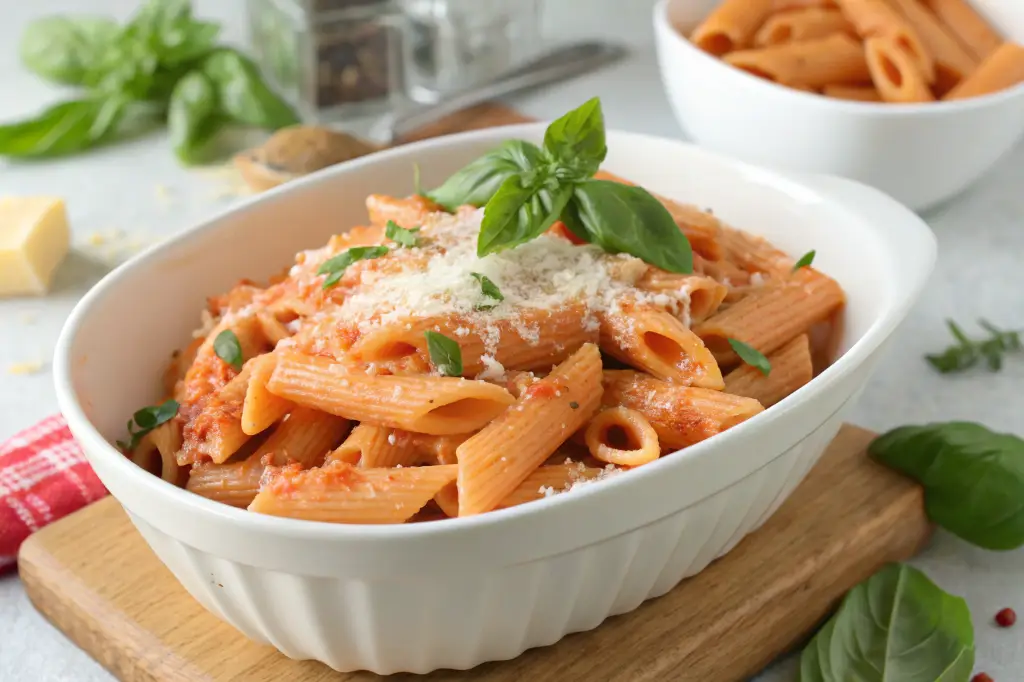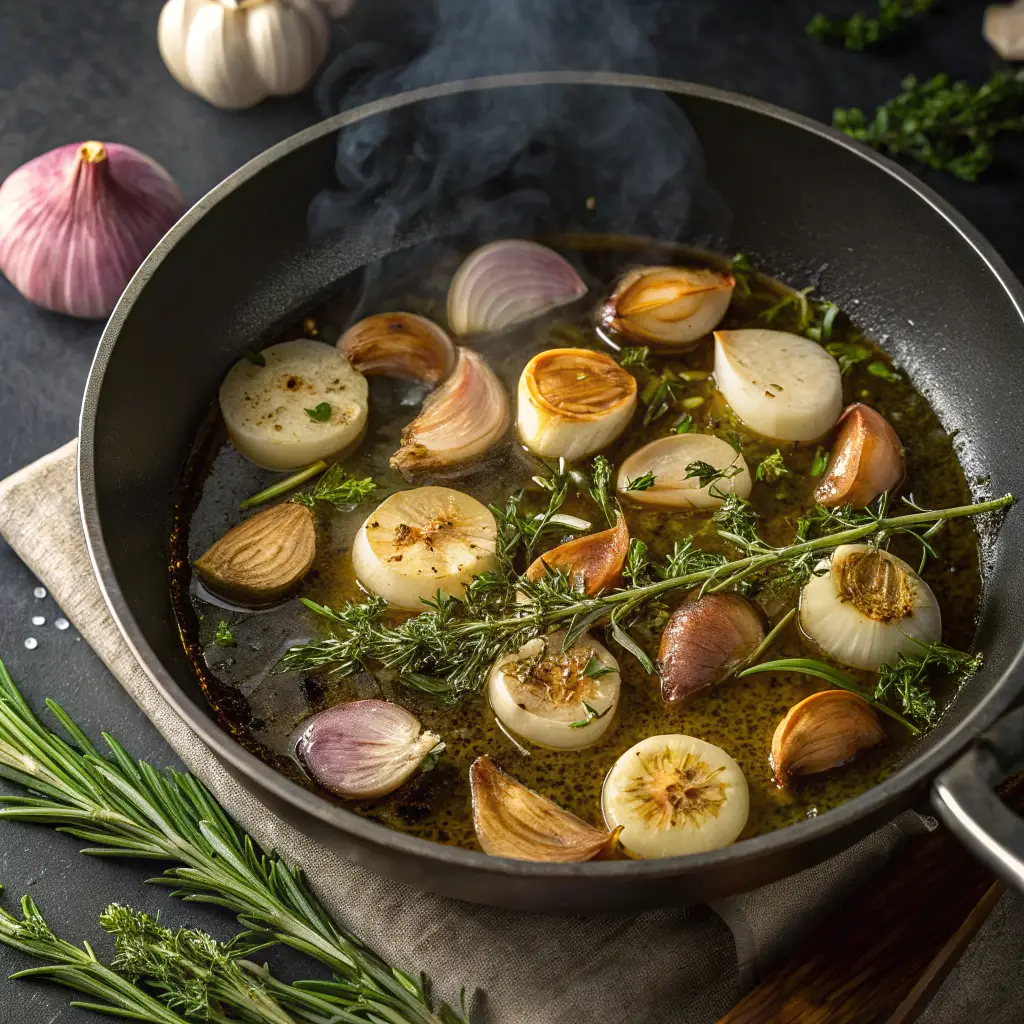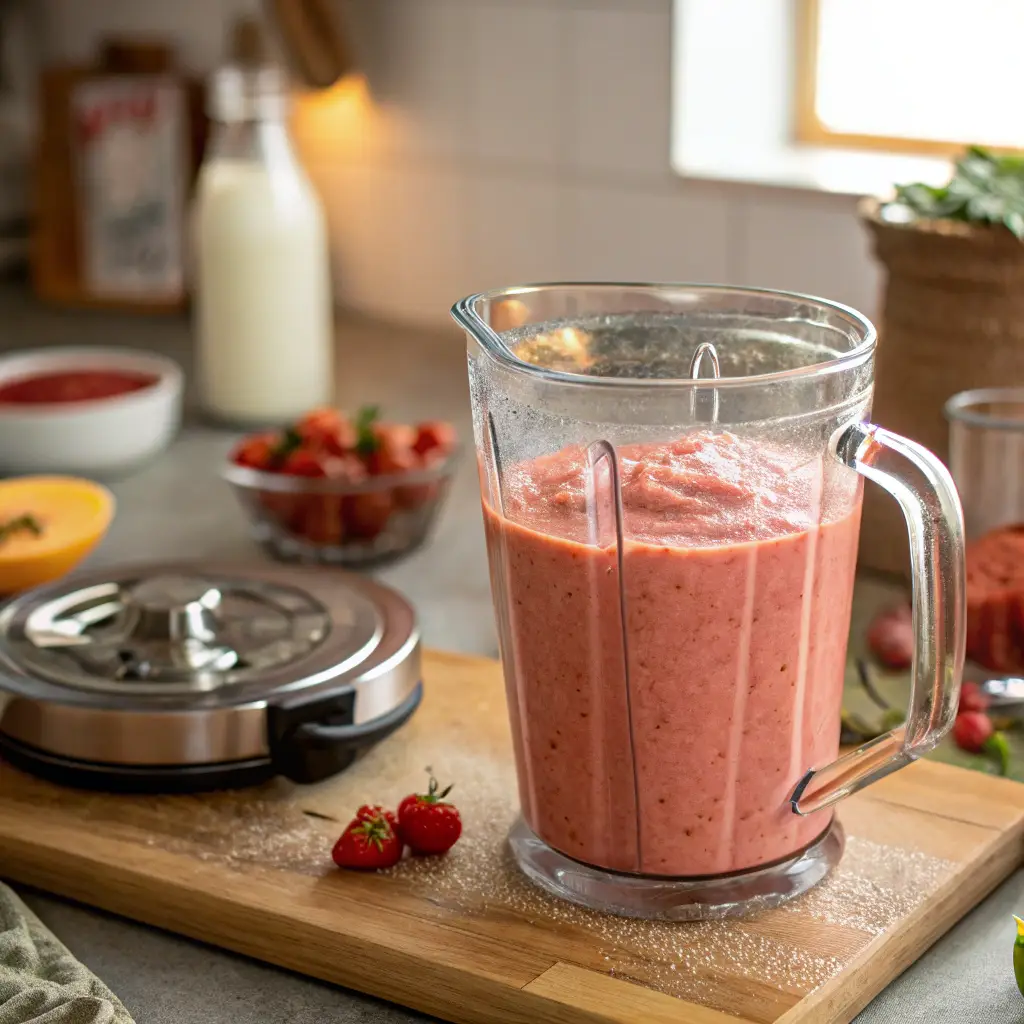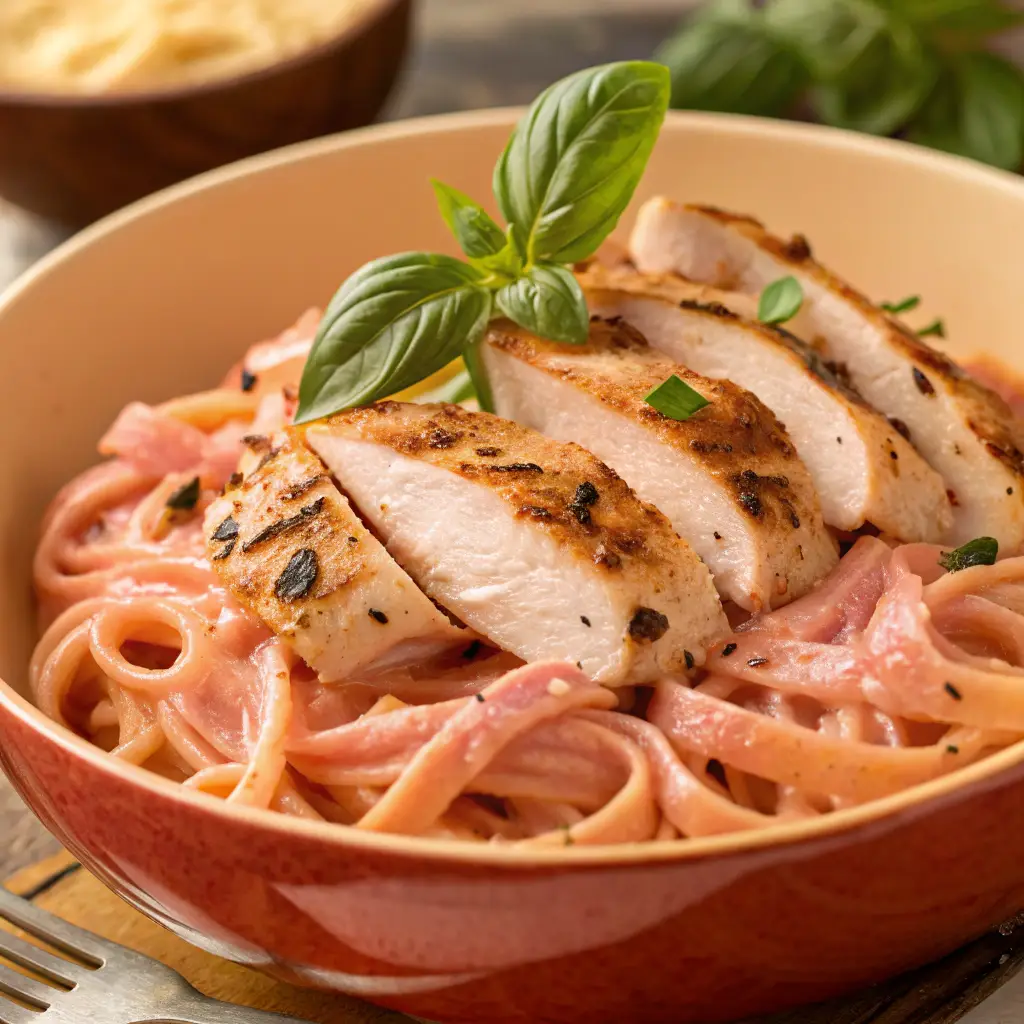Italian pink sauce recipe with pasta is a crave-worthy fusion of creamy indulgence and tangy tomato flavor that’s taken kitchens by storm. If you’ve been searching for the perfect balance between marinara and Alfredo, this is it. This comforting, colorful dish brings together the richness of heavy cream, the bite of garlic, the elegance of San Marzano tomatoes, and the luxurious melt of parmesan cheese—all coating a bowl of perfectly cooked rigatoni.
You’ll discover how this luscious sauce came to be, why it works so well with different types of pasta, and how to cook it flawlessly in your own kitchen. This step-by-step guide includes tips, variations, make-ahead options, and answers to all your burning questions.
Looking for inspiration? Try this authentic version of Italian pink sauce on our recipe hub.
Table of Contents
Table of Contents
What is Italian Pink Sauce recipe with pasta and Why It’s Loved Worldwide
Origins of Italian Pink Sauce
Italian pink sauce, often referred to as “salsa rosa,” is a delightful blend of tomato and cream that delivers a signature blush color and a mellow, comforting flavor. While it doesn’t have a deep-rooted history like marinara or Alfredo, its rise in popularity is due to its ability to blend the tangy bite of tomatoes with the richness of heavy cream. It’s believed to have originated from Italian-American kitchens that wanted to fuse two classic sauces: tomato-based marinara and creamy Alfredo.
This hybrid sauce isn’t traditionally served in Italy but has become a staple in many Italian-style restaurants worldwide, especially in the United States. The simplicity of ingredients and versatility of flavor have made it a go-to recipe for home cooks and chefs alike.
Why It’s Called “Pink” and How It Differs from Other Sauces
The name “pink sauce” comes from the color that results when you combine red tomato sauce and white cream sauce. It sits somewhere between marinara and Alfredo—not as tangy and acidic as marinara, not as rich and buttery as Alfredo. This balance is what makes it so loved.
Here’s a quick comparison table to help understand how pink sauce fits in:
| Sauce Type | Base Ingredients | Texture | Flavor Profile |
|---|---|---|---|
| Marinara | Tomatoes, garlic, onions | Light & chunky | Tangy, herbaceous |
| Alfredo | Butter, cream, cheese | Smooth & heavy | Rich, buttery, savory |
| Pink Sauce | Tomatoes + cream, cheese | Creamy & smooth | Mild, balanced, creamy-tangy |
Pink sauce is also incredibly flexible—it can be made spicy with chili flakes, savory with parmesan, or more aromatic with fresh basil and oregano. This adaptability means it pairs well with various types of pasta, proteins, and even dietary needs (like gluten-free versions).
Discover great ideas like this homemade pink salad dressing if you’re into pink sauces beyond pasta!

The Best Italian Pink Sauce Recipe with Pasta – Creamy, Rich & Easy to Make
Ingredients
Method
- 1. Heat a large skillet over medium heat. Add butter and oil then once butter has melted, add shallot then cook for 3-4 minutes, stirring often. Add garlic and dry spices then cook for 1 minute.
- 2. Add white cream to deglaze the pan, scraping up any browned bits from the pan. Cook for 2-3 minutes.
- 3. Use (clean) hands to crush the whole tomatoes right into the pot, and add the rest of the juice from the can. Reduce heat to low and simmer, partially covered, for 30 minutes.
- 4. Cook rigatoni in salted boiling water, according to package instructions. Reserve 1 cup pasta water, and drain cooked pasta (don’t rinse).
- 5. Use a blender or hand immersion blender to purée the sauce until smooth. Return to pot over low heat.
- 6. Add heavy cream until combined. Add parmesan cheese then stir until melted and smooth. Taste and add additional seasonings if needed. Add cooked pasta and toss to coat. Add some pasta water as needed, to thin the sauce.
- 7. Serve garnished with fresh basil and extra parmesan cheese.
Nutrition
Notes
Tried this recipe?
Let us know how it was!Key Ingredients for the Perfect Pink Sauce Pasta
Breakdown of Core Ingredients (Olive Oil, Garlic, Tomatoes, Cream)
To master the ultimate Italian pink sauce recipe with pasta, you need to start with the right ingredients. This dish may feel luxurious, but the magic lies in its simplicity and ingredient quality.
Let’s break it down:
- Olive oil & butter: This powerful duo lays the flavor foundation. The olive oil adds fruitiness while butter brings richness, creating the perfect base for sautéing.
- Shallots & garlic: Minced garlic and diced shallots are essential aromatics. Shallots add mild sweetness, and garlic brings that bold Italian flavor.
- San Marzano tomatoes: Using a 28-ounce can of whole peeled San Marzano tomatoes ensures a naturally sweet, low-acid tomato base that blends beautifully with cream.
- Heavy cream: The signature creamy texture of pink sauce depends on high-fat dairy. The cream mellows the tomatoes and creates a velvety mouthfeel.
- Parmesan cheese: Freshly grated parmesan thickens and flavors the sauce. Avoid pre-shredded cheese—it won’t melt as smoothly and lacks depth.
- Dry cream (optional): Adds acidity and balance, enhancing the overall flavor of the sauce.
- Herbs & spices: A mix of dried oregano, basil, red chili flakes, salt, and black pepper adds warmth and a layered herb profile.
- Pasta water: Don’t skip this. The starchy water helps bind the sauce and pasta, ensuring perfect texture.
Here’s a visual summary:
| Ingredient | Role in the Sauce |
|---|---|
| Olive oil + Butter | Flavor base |
| Garlic & Shallots | Aromatics |
| San Marzano Tomatoes | Sauce body |
| Heavy Cream | Creamy texture & color |
| Parmesan Cheese | Umami richness |
| Dry cream (optional) | Brightness and depth |
| Seasonings & Herbs | Italian flavor profile |
| Pasta Water | Sauce thickener and smoother |
Importance of Using Quality Cheese and Pasta
Great sauce needs great pasta and cheese to complement it. Low-quality ingredients can break the flavor harmony or ruin the texture. Here’s why it matters:
- Parmesan cheese: Use real Parmigiano-Reggiano if possible, freshly grated at room temperature. Pre-packaged shredded cheeses are often coated with anti-caking agents that prevent smooth melting.
- Rigatoni pasta: Its ridges and tube-like shape are ideal for holding the creamy sauce. Alternatives like penne, farfalle, or fusilli also work well, but stay away from thin spaghetti which doesn’t pair well with heavier sauces.
- Gluten-free pasta: Use high-quality brands made from brown rice or chickpeas for a texture closest to traditional wheat pasta.
Pro tip: Always salt your pasta water generously. It’s your first opportunity to season the pasta from the inside out.
Don’t miss our homepage with seasonal pasta collections for more pasta-focused recipes.
Step-by-Step Guide to Cooking Italian Pink Sauce Recipe with Pasta

Sautéing Aromatics and Spices Correctly
Perfecting an Italian pink sauce recipe with pasta starts with nailing the foundation—your sautéed aromatics. This is where the flavor builds, and if you rush or skip it, your sauce won’t hit the mark.
Start by heating 1 tablespoon olive oil and 2 tablespoons butter over medium heat in a large skillet. Once the butter has melted, stir in 1 finely diced shallot. Let it cook gently for about 3–4 minutes until it softens and becomes translucent. Stir often so it doesn’t brown.
Next, toss in 6 minced garlic cloves. Stir constantly for 1 minute. Once the garlic is fragrant, add your dried herbs and spices:
- 2 teaspoons dried oregano
- 2 teaspoons dried basil
- 1/4 teaspoon red chili flakes (add more if you like heat)
- 1 teaspoon salt
- 1/4 teaspoon freshly ground black pepper
This step is crucial: heating the dried herbs in oil “blooms” their flavor and makes them more aromatic.
At this stage, optionally pour in 1/4 cup cream to deglaze the pan. Stir and scrape up any browned bits (a goldmine of flavor). Let it cook for 2–3 minutes to reduce slightly and mellow the soda.
Blending and Finishing the Sauce the Italian Way

Now comes the heart of the sauce. Pour in the 28-ounce can of whole San Marzano tomatoes, crushing them by hand directly into the pan for a rustic texture. Add all the juices from the can, stir, and reduce the heat to low.
Let the mixture simmer partially covered for 30 minutes. This slow simmer brings out the sweetness in the tomatoes while concentrating their flavor.
While the sauce simmers, cook your 1 pound of rigatoni in a separate pot of salted boiling water according to package instructions. Reserve 1 cup of the pasta water before draining.
Once the sauce is ready, use an immersion blender (or transfer to a blender) to purée it until smooth. Return it to the pan over low heat.
Stir in 1 1/4 cups heavy cream, combining gently until the sauce turns its signature pink color. Then, add 1 cup freshly grated parmesan cheese, stirring until completely melted and creamy.
Now, fold in your cooked rigatoni. Add a splash of the reserved pasta water, little by little, until the sauce clings perfectly to the pasta.
Garnish generously with chopped fresh basil and a touch more grated cheese if desired.
Check out this rich pink salad dressing twist for another way to enjoy creamy, tangy sauces
Best Pasta Types to Pair with Pink Sauce
Choosing Rigatoni, Penne, or Fusilli for Texture
One of the beautiful things about a creamy Italian pink sauce recipe with pasta is how it pairs well with various pasta shapes—but some shine brighter than others. Texture and structure matter here because this sauce is rich and creamy, so you need pasta that can hold onto it.
Here are top picks:
- Rigatoni: A classic choice for pink sauce. Its wide, ridged tubes trap sauce inside and out, making every bite a flavorful one.
- Penne: Slightly narrower than rigatoni but still tubular and ridged, penne pasta is another fantastic match. It offers a slightly firmer bite.
- Fusilli: Its spiral shape makes it excellent for grabbing creamy sauce between the grooves.
- Farfalle: These bow-tie-shaped noodles are not just cute—they’re functional, with pinched centers that grip sauce well.
- Medium Shells: Their cup-like form holds bits of tomato and cheese, delivering a burst of flavor in each bite.
Here’s a quick pasta pairing table:
| Pasta Type | Holds Sauce Well | Texture | Ideal For Creamy Sauces |
|---|---|---|---|
| Rigatoni | Yes | Firm | ✔️ |
| Penne | Yes | Al dente | ✔️ |
| Fusilli | Very Well | Springy | ✔️ |
| Farfalle | Moderately | Soft | ✔️ |
| Spaghetti | Not Ideal | Slippery | ✘ |
Avoid long, thin noodles like spaghetti or angel hair—these don’t cling to creamy sauces well and can leave you with a watery mess instead of a luscious plate.
Gluten-Free or Plant-Based Pasta Alternatives
Don’t worry if you’re gluten-free or following a plant-based diet—you can still enjoy this Italian pink sauce recipe with pasta with a few tweaks.
Here are alternatives worth trying:
- Chickpea pasta (like Banza): High in protein and fiber, with great bite and texture.
- Brown rice pasta: A gluten-free favorite that mimics traditional pasta well.
- Lentil pasta: Earthy flavor and a strong texture, but can be overpowering for delicate sauces—best if balanced with herbs.
- Zoodles or Palmini: For low-carb eaters, spiralized zucchini or hearts of palm pasta are light options that still let the sauce shine.
No matter which pasta you choose, cook it just shy of al dente before tossing in the sauce—this allows the pasta to finish cooking while soaking in the flavors.
Don’t miss our homepage full of new pasta sauces for more tasty options and ideas.
Italian Pink Sauce Recipe with pasta Variations You’ll Love

Adding Proteins: Chicken, Shrimp, or Tofu
This Italian pink sauce recipe with pasta is versatile enough to become the base for countless delicious variations. One of the easiest ways to upgrade it? Add protein.
Here are three flavorful options:
- Grilled or pan-seared chicken: Season boneless chicken breasts with salt, pepper, and a little oregano, then cook and slice into strips. Add them to the sauce right before combining with the pasta.
- Sautéed shrimp: Cook peeled shrimp in olive oil and garlic until pink. Their natural sweetness pairs beautifully with the creamy tomato base.
- Pan-fried tofu: For a plant-based version, use firm tofu. Press and cube it, then pan-fry until golden. Tofu absorbs the flavors of the sauce without overpowering it.
Protein Tip: Always cook the protein separately to ensure it browns properly, then fold it into the finished sauce.
Here’s a protein pairing chart:
| Protein | Cooking Time | Flavor Profile | Best For |
|---|---|---|---|
| Chicken | 10–15 mins | Mild, hearty | Family-style meals |
| Shrimp | 5–7 mins | Sweet, briny | Lighter seafood twist |
| Tofu | 8–10 mins | Neutral, savory | Vegan/Vegetarian |
Spicing It Up: Red Chili Flakes, Herbs
Looking to elevate your pink pasta sauce even more? These flavor enhancers can take it from comforting to gourmet:
- Red chili flakes: A little heat transforms the sauce into a spicier, more dynamic version—great for adult palates.
- Fresh herbs: In addition to basil, try adding fresh chopped parsley or thyme at the end for a burst of green flavor.
- Lemon zest: Grate a small amount of lemon zest into the finished sauce for brightness and contrast to the richness of the cream.
Bonus Idea: Add sun-dried tomatoes or roasted red peppers during the blending step for a deeper, smoky tomato flavor.
Expert Tips for Creamy, Restaurant-Quality Pink Sauce
Avoiding Common Mistakes Like Curdling or Grainy Texture
Even though the Italian pink sauce recipe with pasta is simple, there are a few easy mistakes that can ruin the luxurious texture you’re aiming for. Here’s how to avoid them:
- Don’t add cream over high heat: High heat can cause the cream to separate or curdle. Always reduce the heat to low before stirring it in.
- Use freshly grated cheese: Pre-shredded parmesan has anti-caking agents that prevent it from melting smoothly. Always use high-quality parmesan and let it come to room temperature before adding.
- Don’t over-blend: When using a blender, pulse gently. Over-blending introduces air and can make the sauce frothy or thin.
- Avoid cold ingredients: Adding cold cream or cheese to hot sauce can shock the emulsion. Let your ingredients warm up to room temperature first.
- Add salt gradually: Parmesan is naturally salty, so season in layers and always taste before adding more salt at the end.
Here’s a cheat sheet for troubleshooting:
| Issue | Cause | Fix |
|---|---|---|
| Sauce curdled | Cream added over high heat | Lower heat before adding cream |
| Cheese clumped | Cold cheese or pre-shredded | Use room-temp, freshly grated cheese |
| Sauce too thin | Too much pasta water or not reduced | Simmer longer or add more cheese |
| Sauce too acidic | Low-quality tomatoes or overcooked | Add pinch of sugar or extra cream |
Secrets to Balancing Acidity and Creaminess
Balancing acidity from the tomatoes and richness from the cream is the real art of pink sauce. Here’s how to strike that perfect balance:
- Tomato quality matters: Use San Marzano or similar low-acid whole peeled tomatoes. The sweetness helps cut down sharp acidity.
- Add cream slowly: Stir it in bit by bit, tasting as you go to ensure balance.
- Cheese as a balancer: Parmesan not only thickens but also adds salty depth that enhances both cream and tomato.
- Finish with fresh herbs: A handful of chopped basil or parsley added at the end can freshen the dish and add lightness.
Optional twist: Add a pinch of sugar if your tomatoes taste too sharp or acidic—it’s a classic Italian grandma trick that still holds up today.
Don’t miss our best ideas for creamy tomato-based sauces to keep experimenting in the kitchen.
Make Ahead, Freezing, and Reheating Instructions
How to Prep Pink Sauce in Advance Without Losing Flavor
One of the best things about this Italian pink sauce recipe with pasta is how easy it is to make ahead for busy weeknights, meal prep, or entertaining.
If you’re planning to cook in advance, follow this method:
- Make only the sauce: Cook the tomato base, blend it smooth, and refrigerate before adding cream, cheese, or pasta. This preserves the texture and prevents separation.
- Store in an airtight container: Let the sauce cool completely, then store it in a tightly sealed glass jar or container.
- Shelf life: The pre-cream sauce will stay fresh in the fridge for up to 5 days.
When ready to serve:
- Warm the sauce gently in a skillet over medium-low heat.
- Stir in the cream and parmesan cheese just before serving.
- Add cooked pasta and toss with a splash of pasta water.
This method ensures your sauce remains silky and fresh.
Freezer-Friendly Pink Sauce Tips
Want to save your sauce for a rainy day? Freezing pink sauce is totally doable with one big rule: don’t freeze the cream or cheese part.
Follow these freezer-safe steps:
- Stop after simmering tomatoes: Freeze the base sauce (after blending) before adding cream and cheese.
- Cool completely before freezing.
- Freeze in small portions: Use zip-lock freezer bags or silicone ice cube trays for easy portion control.
- Label and date: It’ll keep well in the freezer for up to 2 months.
To reheat:
- Thaw overnight in the fridge.
- Warm gently on the stove.
- Then stir in cream, cheese, and pasta to finish.
Bonus tip: You can even prep the entire meal minus cream and cheese, freeze the cooked pasta and sauce base separately, and combine when you’re ready.
Nutritional Information and Serving Suggestions
Calories, Macros, and Health Considerations
When enjoying this delicious Italian pink sauce recipe with pasta, it’s helpful to know what you’re eating—especially if you’re tracking calories or managing dietary needs.
Here’s the nutritional breakdown per serving (about 1.5 cups or ~340g):
| Nutrient | Amount |
|---|---|
| Calories | 739 kcal |
| Carbohydrates | 82g |
| Protein | 21g |
| Fat | 36g |
| Saturated Fat | 20g |
| Sodium | 1112mg |
| Fiber | 5g |
| Sugar | 9g |
| Cholesterol | 97mg |
| Calcium | 328mg |
| Iron | 4mg |
| Vitamin A | 1680 IU |
| Vitamin C | 18mg |
| Potassium | 684mg |
Health Tips:
- Want it lighter? Substitute half the heavy cream with whole milk or use a plant-based alternative like oat or cashew cream.
- Need less sodium? Use unsalted butter and low-sodium canned tomatoes.
- Boost fiber with whole wheat or legume-based pasta.
Perfect Garnishes and Side Dishes to Serve With It
This sauce is so creamy and flavorful that you don’t need to go overboard with sides—but pairing it well enhances the meal. Here are simple, flavorful ideas:
Garnishes:
- Fresh chopped basil
- Extra parmesan cheese
- Cracked black pepper
- Drizzle of olive oil
Side Dish Suggestions:
- Garlic bread or rustic sourdough slices for scooping up extra sauce
- Crisp Caesar salad for contrast and freshness
- Steamed broccoli or grilled zucchini for balance
- Roasted cherry tomatoes to boost the tomato flavor naturally
Hosting a dinner party? Try serving small portions of pink pasta as a first course followed by grilled chicken or shrimp mains.
FAQs About Italian Pink Sauce Recipe with Pasta
What is Italian pink sauce for pasta?
Italian pink sauce is a creamy tomato-based sauce made by combining a red sauce (like marinara) with a white sauce (like Alfredo). It’s called “pink” because of the soft blush color that results from mixing tomatoes and heavy cream. It’s smooth, flavorful, and often seasoned with garlic, basil, and parmesan cheese. This versatile sauce works wonderfully with many types of pasta and is beloved for its perfect balance of tanginess and richness.
How to make good pink sauce pasta?
Making great pink sauce pasta comes down to a few key steps:
Start with aromatics – Sauté garlic and shallots in olive oil and butter for rich flavor.
Use quality tomatoes – San Marzano whole peeled tomatoes are ideal for smoothness and sweetness.
Simmer then blend – Let the sauce reduce before blending to deepen the flavor.
Add cream off heat – Stir in heavy cream slowly over low heat to avoid curdling.
Use fresh cheese – Grate your parmesan fresh for the smoothest, most flavorful result.
Finish with fresh basil and pasta water to perfect the texture and taste.
What are the ingredients of pink sauce?
The core ingredients for a classic Italian pink sauce recipe with pasta include:
Olive oil and butter
Garlic and shallot
Dried oregano and basil
San Marzano tomatoes
Heavy cream
Fresh parmesan cheese
Pasta (like rigatoni or penne)
Salt, pepper, and optional red chili flakes
You can also enhance it with add-ins
What pasta goes with pink sauce?
Creamy pink sauce pairs best with short, sturdy pasta shapes that hold sauce well. Top choices include:
Rigatoni – ridged and tube-shaped for maximum sauce cling
Penne – similar to rigatoni, with a firmer bite
Fusilli – spirals that trap creamy sauce perfectly
Farfalle – bowties that offer a soft chew and scoop sauce nicely
Shells – their cup-like shape holds creamy bites well
Avoid thin strands like spaghetti or angel hair, which don’t support heavier sauces as effectively.
Conclusion: Creamy, Easy, and Irresistible – This Italian Pink Sauce Recipe with Pasta is a Must-Try
There you have it—the complete guide to mastering the Italian pink sauce recipe with pasta that’s creamy, comforting, and bursting with flavor. Whether you’re cooking for a cozy weeknight dinner or a special gathering, this dish offers flexibility, elegance, and crowd-pleasing appeal. From understanding the origins to choosing the right pasta and avoiding cooking mistakes, you now have all the tools to bring this restaurant-style favorite home.
Don’t forget to explore more pasta pairings and recipe twists!
Discover great content like this and more pink-hued recipes on our official Facebook page—where flavor meets creativity every day.
